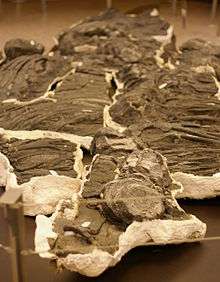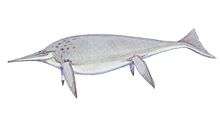Shastasauridae
Shastasauridae is an extinct family of Triassic ichthyosaurs that includes the genera Shastasaurus and Himalayasaurus.[1] Many other Triassic ichthyosaurs have been assigned to Shastasauridae in the past, but recent phylogenetic analyses suggest that these species form an evolutionary grade of early ichthyosaurs rather than a true clade or evolutionary grouping that can be called Shastasauridae. Shastasauridae was named by American paleontologist John Campbell Merriam in 1895 along with the newly described genus Shastasaurus. In 1999, Ryosuke Motani erected the clade Shastasauria to include Shastasaurus, Shonisaurus, and several other traditional shastasaurids, defining it as a stem-based taxon including "all merriamosaurians more closely related to Shastasaurus pacificus than to Ichthyosaurus communis." He also redefined Shastasauridae as a node-based taxon including "the last common ancestor of Shastasaurus pacificus and Besanosaurus leptorhynchus, and all its descendants" and Shastasaurinae, which Merriam named in 1908, as a stem taxon including "the last common ancestor of Shastasaurus and Shonisaurus, and all its descendants."[2] In an alternative classification scheme, paleontologist Michael Maisch restricted Shastasauridae to the genus Shastasaurus and placed Shonisaurus and Besanosaurus in their own monotypic families, Shonisauridae and Besanosauridae.[3][4]
| Shastasauridae Temporal range: Triassic | |
|---|---|
 | |
| Skeleton of Shastasaurus sikanniensis | |
| Scientific classification | |
| Kingdom: | Animalia |
| Phylum: | Chordata |
| Class: | Reptilia |
| Order: | †Ichthyosauria |
| Node: | †Merriamosauria Motani, 1999 |
| Family: | †Shastasauridae Merriam, 1895 |
| Genera | |
Feeding Habits
Unlike other Triassic ichthyosaurs, which fed almost exclusively on cephalopods,[5] shastasaurians fed on a variety of prey.[6] Evidence for this prey diversity includes gut contents from Guizhouichthyosarus tangae, Shonisaurus popularis, and an unnamed specimen from the Brooks Range of Alaska.[6]
References
- Fröbischa, N. B.; Fröbischa, J. R.; Sanderb, P. M.; Schmitzc, L.; Rieppeld, O. (2013). "Macropredatory ichthyosaur from the Middle Triassic and the origin of modern trophic networks". Proceedings of the National Academy of Sciences. 110 (4): 1393–1397. Bibcode:2013PNAS..110.1393F. doi:10.1073/pnas.1216750110. PMC 3557033. PMID 23297200.
- Motani, R. (1999). "Phylogeny of the Ichthyopterygia". Journal of Vertebrate Paleontology. 19 (3): 473–496. doi:10.1080/02724634.1999.10011160.
- Michael W. Maisch (2010). "Phylogeny, systematics, and origin of the Ichthyosauria – the state of the art" (PDF). Palaeodiversity. 3: 151–214.CS1 maint: uses authors parameter (link)
- Sander, P. M.; Chen, X.; Cheng, L.; Wang, X. (2011). Claessens, Leon (ed.). "Short-Snouted Toothless Ichthyosaur from China Suggests Late Triassic Diversification of Suction Feeding Ichthyosaurs". PLoS ONE. 6 (5): e19480. Bibcode:2011PLoSO...619480S. doi:10.1371/journal.pone.0019480. PMC 3100301. PMID 21625429.
- Rieber, Hans (May 1970). "Phragmoteuthis? ticinensis n. sp., ein Coleoidea-Rest aus der Grenzbitumenzone (Mittlere Trias) des Monte San Giorgio (Kt. Tessin, Schweiz)". Paläontologische Zeitschrift. 44 (1–2): 32–40. doi:10.1007/bf02989793. ISSN 0031-0220.
- Druckenmiller, Patrick S.; Kelley, Neil; Whalen, Michael T.; Mcroberts, Christopher; Carter, Joseph G. (2014-09-19). "An Upper Triassic (Norian) ichthyosaur (Reptilia, Ichthyopterygia) from northern Alaska and dietary insight based on gut contents". Journal of Vertebrate Paleontology. 34 (6): 1460–1465. doi:10.1080/02724634.2014.866573. ISSN 0272-4634.

